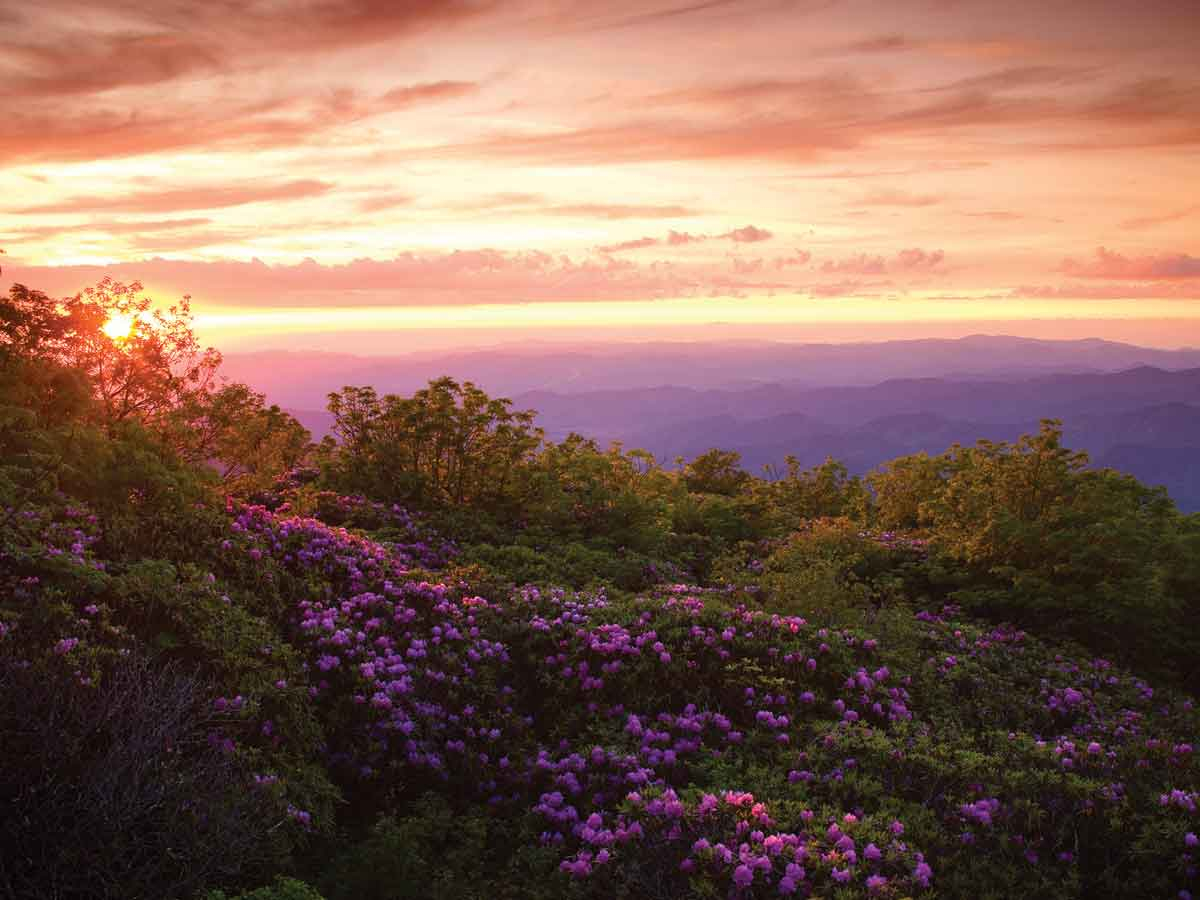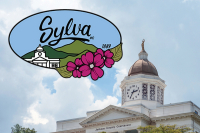‘A lot of mistakes’: Objections level strong criticism against forest plan
 A stunning view stretches out in the Craggy Forest Scenic Area. Steven McBride photo
A stunning view stretches out in the Craggy Forest Scenic Area. Steven McBride photo
The 60-day objection period for the Pisgah-Nantahala Forest Management Plan is now over, and while there’s not yet an official tally of how many people are contesting the final plan, it’s safe to say it’s a high number.
I Heart Pisgah , a coalition of more than 150 organizations supporting increased protections for the forest, has record of more than 14,000 objections filed against the plan. That figure reflects only the objections that I Heart Pisgah and coordinating organizations helped submit, so the true total is even higher. The U.S. Forest Service has until April 1 to post the objections to its website — until then, the total number is not available.
This extraordinary number of objections comes toward the end of an extraordinarily long process to plan the future of the 1.04 million acres contained in the Pisgah and Nantahala National Forest. The Forest Service first started reaching out to stakeholders in 2012, and after a decade of public meetings, arguments, negotiations and exhaustive rounds of public comment, the final plan was released in January.
While the draft released in February 2020 earned praise from a wide range of interest groups, many of which sparred vigorously throughout the planning process, the final plan met a chilly reception from many of those same groups — particularly from those focused on preserving wilderness and old growth.
The objections reflect that. While a complete record of objections was not available as of press time, The Smoky Mountain News reached out to a diverse set of companies, nonprofits and coalitions that have participated in the planning process for years. Overwhelmingly, the longest, most strongly worded objections came from the pro-preservation side of the aisle — in fact, 100 organizations and businesses endorsed a report card from the Center for Biological Diversity that gives the plan an F.
Related Items
“The plan is, in a word, a disappointment,” reads a 179-page objection from the Southern Environmental Law Center , submitted on behalf of The Wilderness Society , MountainTrue , Defenders of Wildlife and the Sierra Club . “At this stage of the process, we never imagined there would be so much left to do. It takes a lot of mistakes to get something so wrong. The lengthy objection below is a function of the plan’s failure to take its legal obligations seriously, along with its lack of credible analysis.”
However, core to the SELC’s criticism — and to that of various other objections SMN obtained — is the ways in which the Forest Service declined to incorporate solutions from the Nantahala Pisgah Forest Partnership , a group of more than 20 organizations spanning interests ranging from logging to wilderness that spent years hammering out a proposal that the diverse interests represented within the partnership could get behind.
“The Partnership has collaborated with the Forest Service for nearly a decade on this management plan,” said a statement from Ashleigh Sherman of Darby Communications on behalf of the Partnership. “However, the Partnership was disappointed to see a number of their proposals excluded from the latest draft.”
Missing triggers
One such proposal relates to the Tier 1 and Tier 2 objectives contained in the final plan. The tiered approach was the Partnership’s attempt to broker consensus between groups with opposing priorities for forest management. For example, the approach might require the forest to meet certain requirements for controlling invasive species or protecting water quality before moving from base-level Tier 1 logging objectives up to higher-order Tier 2 harvest goals.
The final plan keeps the tiers but doesn’t link them between interests. That is, under the proposed plan the Forest Service can move to Tier 2 logging goals, for example, without worrying about whether Tier 1 objectives have been met for water quality or invasive species control.
“The agency’s approach fails to meet the purpose and need of the plan, as well as stated desired conditions and objectives … Our Partnership members and affiliates stretched well beyond their comfort zone, and farther than they may have otherwise been able to in order to balance all stakeholder needs to the fullest extent possible,” reads the Partnerships objection. By failing to tie the tiers, it says, the Forest Service destroyed that balance.
In a February interview , Lead Planner Michelle Aldridge said that the Forest Service defines Tier 1 goals as what the Forest Service can do with its current staff and resources, while Tier 2 goals will require outside resources such as grants to accomplish.
“Think about it,” she said. “If road maintenance money arrived tomorrow, but we hadn’t yet completed all of our plan activities for non-native invasives, we’re not going to pause on our road maintenance until we get our non-native invasive work done. If we have the opportunity to do more, we’re going to do those things, whether that’s more fish passages or sustainable trails or whatever the case may be.”
The SELC included this quote in its objection, along with a sharp reply.
“This response misses the point entirely,” the SELC objection said. “Road maintenance needs are not exacerbated by treating non-native invasive species, improving fish passage, or building sustainable trails. But some plan objectives are in direct tension with other resource protection obligations … Triggers are an adaptive management strategy to show that the forests are capable of mitigating harm before moving to ‘stretch goals.’”
Roadbuilding and timber harvest are very much connected. According to SELC’s objection, the plan puts 610,434 acres of the forest in management areas considered suitable for timber harvest. Half of these are currently inaccessible, meaning that extracting timber would require building new roads.

A biker pedals the Staire Creek Trail. Steven McBride photo
Old growth protections
The Forest Service’s solution for old growth forest was also a target of criticism for many objectors. The plan establishes a 265,000-acre old growth network, but many of those acres do not contain old growth trees, and some acreage known to contain such trees is not included in the network. In its objection, the Partnership also pointed out that the plan did not incorporate its suggestion of a cap-and-trade approach to the network, which would have allowed the Forest Service to trade lower-quality patches for higher-quality ones as they were spotted during projects.
“The plan authorizes cutting over 44,000 acres of existing designated old-growth,” I Heart Pisgah claims in its objection. “Over a quarter-million acres of old growth is placed in logging-priority designations. Twenty percent of the highest-priority logging lands contain known, inventoried old-growth forests.”
The objection claims these shortcomings are due to inaccurate models for old growth and natural disturbances that are built on “misleading assumptions” and “fundamentally flawed.”
“The Forest Service has tweaked model inputs so that the models intentionally underestimate the amount of natural disturbance historically and overestimate natural disturbance in the future,” says the objection. “The Forest Service is attempting to create artificial need for timber harvests and inflate numbers for its own benefit rather than aiming for accurate NRV (natural range of variation) conditions.”
In particular, I Heart Pisgah objects to the fact that the plan excludes 4,000 acres of the 16,000-acre Craggy/Big Ivy Section from protection as a Forest Scenic Area — though the coalition had hoped to see it granted recommendation for the more protective National Scenic Area designation — placing them instead in a logging-eligible management area.
“These highest-priority logging areas in Craggy/Big Ivy include 1,500 acres of old-growth forest, the headwaters of the Ivy River (the drinking water source for the town of Weaverville), and the Snowball Trail, one of the most popular trails along the Blue Ridge Parkway,” the objection reads. “The Craggy National Scenic Area designation was also dismissed and never studied by the Forest Service without any explanation. The best and highest use of Craggy/Big Ivy is as a Forest Scenic Area/National Scenic Area that protects this world-class viewshed, ancient forest, rare species refuge, recreational hub and critical drinking water supply for Buncombe County.”
I Heart Pisgah was far from being the only organization to object to the 4,000 acres excluded from protection at Craggy/Big Ivy. The Partnership, SELC, Save the Ivy River, and even Buncombe County — among others — echoed those concerns.
Shortcomings for recreation
The Partnership also took issue with provisions of the plan that it said would be bad news for various recreation interests.
First, the Partnership said the plan doesn’t incorporate recommendations that aimed to head off existing or impending conflicts between user groups and sustainability goals. In rejecting these ideas, the Partnership wrote, “the Forest Service has chosen a future with more conflicts and less collaboration, and with less satisfied visitors, and is failing to adequately provide for sustainable recreation as is required by the 2012 Forest Planning Rule.”
The plan also includes regulations that will negatively impact specific recreation groups, the Partnership said.
In its objection, partnership member Access Fund-Carolina Climbers said that the plan constrains new and existing climbing routes in ways not supported by appropriate analysis, monitoring or evaluation, and that some objectives constitute a cart-before-the-horse situation — the Forest Service should first create a climbing management plan to determine if the constraints are necessary. The Access Fund also claims that the plan unfairly penalizes climbers when, in its quest to protect peregrine falcons, it focuses management on four specific recreation uses while leaving out other activities known to disturb the falcons.
The paddling community also raised serious concerns with what’s in the plan — and with what’s not in it. The Forest Service excluded paddling management on the Chattooga River from the plan’s scope, “the result being the continuation of outdated limits on paddling in the Final Plan despite a decade of data showing low use and no issues stemming from paddling,” Partnership member American Whitewater wrote in its objection. The organization claimed that the plan did not meet the legal standard to remove paddling management from consideration and is violating the National Environmental Policy Act and the Administrative Procedures Act by keeping the limits in place despite “countervailing data.”
American Whitewater — among other objectors — also took issue with the Forest Service’s finding that the Tuckasegee River, Panthertown Creek, Greenland Creek and the North Fork of the French Broad River are not eligible for Wild and Scenic River designation. The decision was the result of “misapplied agency policy” and “inaccurate, irrelevant or inferior information.” For example, American Whitewater’s objection says, the Forest Service deemed the Upper Tuckasegee ineligible because a dam controls the flow below it. However, American Whitewater argues, “agency policy is clear” that Wild and Scenic Rivers can have dams and diversions immediately upstream and downstream of the protected reach.

The sky explodes with color from a viewpoint on the Pisgah Ranger District. USFS photo
Complications for young forest
Since the beginning of the planning process, it’s been apparent that the main tension lies between groups that want to see more protection for wilderness and old growth and those who prioritize active management — especially timber harvest and prescribed fire — to open up more young forest habitat on the aging landscape.
That said, it comes as no surprise that the joint objection submitted by supporters of the latter cause focused on different issues than those written by groups like the SELC and I Heart Pisgah. The objection, written by the Ruffed Grouse Society and American Woodcock Society , was also signed by Luke Weingarten and Tyler Ross of the N.C. Backcountry Hunters and Anglers , David Whitmire of the Fish and Wildlife Conservation Council, Orrin Goure of Columbia Forest Products , Rob Elliott of Evergreen Packaging and John Hatcher of the N.C. Forestry Association . “Urgent action is needed at the landscape scale, above and beyond localized habitat improvement efforts, to halt the decline in ruffed grouse and other forest wildlife in Western North Carolina before it is too late,” the document reads. “The best available science suggests that maintaining 8-14% early successional habitat across the Nantahala and Pisgah National Forests would optimize for bird diversity.”
Both the RGS&AWS and N.C. Backcountry Hunters and Anglers are Partnership members, but because they joined after the group sent in its comments on the draft plan last summer, they abstained from signing the Partnership objection to avoid jeopardizing the Partnership’s standing. However, the groups’ objections are not at odds with each other — Evergreen Packaging, a Partnership member, signed on to both.
The RGS&AWS’ 12-page objection focuses on issues that the groups believe could jeopardize goals for young forest creation. The Partnership objection also voices concern that the plan will not provide enough open forest habitat.
First on the list is the Forest Service’s definition of a young forest patch as anything half an acre or larger in size. However, RGS&AWS writes, the Forest Service’s Resources Planning Act Assessment puts the minimum size at 1 acre, creating an inconsistency that will lead to overpredicting the amount of functional young forest any given action will create. That could have disastrous consequences for game species.
“The plan will likely perpetuate current declines with given assumptions,” the objection reads.
The group also takes issue with how the Forest Service factored historic human-caused disturbance into its assumptions. The model used to determine the natural range of variation of the forest — and, by extension, the condition that the Forest Service aims its management to return it to — does not consider Native American land management impacts, such as burning and agriculture, RGS&AWS writes.
“Also, the NRV model did not consider non-human natural disturbances caused by keystone wildlife species that are now extinct or extirpated, including eastern bison, elk and passenger pigeons,” the objection reads. “Therefore, the NRV model likely underestimates the amount of historic young and open forest and inflates the role of current natural disturbances in providing desired conditions. It discounts the role of people in maintaining desired forest structural conditions.”
While the model fails to consider human impacts in that context, it includes human-caused wildfire as a contributing factor in new young forest creation. As the RGS&AWS sees it, it is “inappropriate” to include human-caused disturbance in one model but not in another.
“Also, assuming that recent human-induced wildfire will continue into the future is not accurate because it assumes a continuity of social behavior without considering other social variables,” the objection reads.
Final steps
The Forest Service has a deadline of April 1 to determine which objectors have standing to file. Those granted standing will be invited to participate in talks this spring and summer to iron out the issues raised and guide the Forest Service to the final version of its final plan.
To have standing, an objector must have submitted comments during an earlier comment period concerning the same issue as the current objection. However, anybody objecting to information in the final plan that was not included in draft versions is exempt from that requirement.
Anyone who submitted formal comments but doesn’t qualify for standing as an objector can file a request for recognition as an “interested person,” a designation that allows for participation in the objection resolution meetings. While the meetings will be open to the public, only objectors and interested persons will be allowed to participate in the dialogue.
The objection resolution process will take at least 90 days, though there’s opportunity to extend it if more time is needed. The Forest Service expects to be operating under the new plan by the middle of the year — and to keep it in place for the next 15-20 years.
Learn more
The latest updates, including filed objections, will be posted on the forest plan website at bit.ly/22forestplan.









